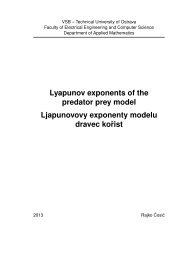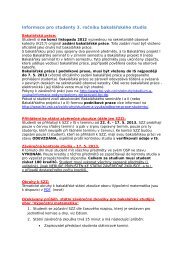The Boundary Element Method for the Helmholtz Equation ... - FEI VÅ B
The Boundary Element Method for the Helmholtz Equation ... - FEI VÅ B
The Boundary Element Method for the Helmholtz Equation ... - FEI VÅ B
You also want an ePaper? Increase the reach of your titles
YUMPU automatically turns print PDFs into web optimized ePapers that Google loves.
9Note that <strong>the</strong> trace operator is not surjective, i.e., <strong>the</strong>re exist functions in L 2 (∂Ω) thatare not traces of any function in Hloc 1 (Ω). <strong>The</strong>re<strong>for</strong>e, we introduce H1/2 (∂Ω) as <strong>the</strong> tracespace of Hloc 1 (Ω), i.e.,H 1/2 (∂Ω) := γ 0 (Hloc 1 (Ω)).Obviously, H 1/2 (∂Ω) is a linear subset of L 2 (∂Ω). Equipped with <strong>the</strong> Sobolev–Slobodeckiinorm ∥u∥ H 1/2 (∂Ω) := ∥u∥ 2 L 2 (∂Ω) + |u(x) − u(y)| 2 1/2∥x − y∥ 3 ds x ds y∂Ω<strong>the</strong> space is complete. Note that <strong>for</strong> a bounded domain Ω we have an equivalent norm∥u∥ H 1/2 (∂Ω) :=We define H −1/2 (∂Ω) as <strong>the</strong> dual space to H 1/2 (∂Ω), i.e., ∗H −1/2 (∂Ω) := H 1/2 (∂Ω)with <strong>the</strong> standard supremum norm∂Ωinf ∥v∥ H 1 (Ω). (1.5)v∈H 1 (Ω)γ 0 v=u∥f∥ H −1/2 (∂Ω) :=supu∈H 1/2 (∂Ω)u≠0|⟨f, u⟩|∥u∥ H 1/2 (∂Ω). (1.6)For a relatively open part of <strong>the</strong> boundary Γ ⊂ ∂Ω we define <strong>the</strong> spacesH 1/2 (Γ ) := v = ṽ| Γ : ṽ ∈ H 1/2 (∂Ω) ,H 1/2 (Γ ) := v = ṽ| Γ : ṽ ∈ H 1/2 (∂Ω), supp ṽ ⊂ Γ , ∗H −1/2 (Γ ) := H 1/2 (Γ ),∗H −1/2 (Γ ) := H 1/2 (Γ ).<strong>The</strong>se spaces will be used <strong>for</strong> <strong>the</strong> purposes of mixed boundary value problems. For a moredetailed treatment on this topic see [12] or [18].1.4 Generalized Normal DerivativesLet us now assume that Ω denotes a bounded domain. Recall that <strong>for</strong> a function u ∈ H 1 (Ω)<strong>the</strong>re exists a unique trace γ 0 u ∈ H 1/2 (∂Ω) generalizing <strong>the</strong> notion of a restriction to<strong>the</strong> boundary. To generalize a normal derivative in <strong>the</strong> same way we would need higherwould have to be inH 1 (Ω). In <strong>the</strong> following section we will, however, show that it is possible to introducenormal derivatives <strong>for</strong> functions in H 1 (Ω, ∆ + κ 2 ).regularity of u. Namely, <strong>the</strong> distributional partial derivatives ∂u∂x k









